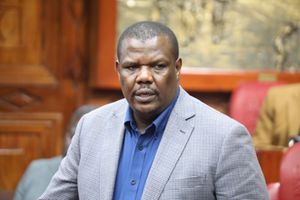Schools need policy to protect our children

Janet Mulei, founder and proprietor of Diamond Junior School on Likoni Road in Nairobi, guides her pupils during a class session on May 10, 2016. Children must be protected and cared for at all times. PHOTO | MARTIN MUKANGU | NATION MEDIA GROUP
What you need to know:
- The Bill of Rights recognises the rights and safety of children and so do other statutes such as the Basic Education Act, the Children’s Act, and the Teachers’ Code of Conduct.
- An ICT and e-safety policy for schools is needed and parents should be part of it as children have more access to these technologies at home.
Recent events in schools have once again raised critical questions about our commitment and collective role in the safeguarding of children.
Recent media reports range from unacceptable corporal punishment to students either being bullied or sexually abused.
While children are well covered by laws, the provisions are often observed in breach. The Bill of Rights recognises the rights and safety of children and so do other statutes such as the Basic Education Act, the Children’s Act, and the Teachers’ Code of Conduct.
Despite these laws, children are not any safer as their enforcement remains weak. At home and in school, children are exposed to various types of unsafe treatment, including physical, sexual, and emotional abuse as well as denial of basic rights such as sanitation and proper health care.
This is why the government-fronted plan to establish a national children’s protection system should also develop a child protection policy to be adopted by schools or used as a guide to develop theirs.
The National Council for Children’s Services (NCCS), which is spearheading the initiative, should speed up the process to stem the rising cases of abuse in schools and homes.
The Framework for the National Child Protection System for Kenya presents a strong case for child protection policies for schools.
Children spend most of their time in school, therefore their safety there must be enhanced. Currently, there is no legal mandate for schools to ensure the safety of their students.
The closest document addressing this is the Safety Standards Manual for Schools released in 2008. Unfortunately, few school managers and teachers implement it.
Most public and private school managements do not know the laws protecting children and do not, therefore, even know when the laws are breached.
An obvious example is corporal punishment, which has been banned yet is still commonly practised in most schools.
The overall purpose of a national child protection system is to promote the wellbeing of children through prevention of violence and exploitation, and to ensure that in case it happens, prompt and coordinated action is taken to prevent further occurrence.
BLOWBACK
Any solution must involve all stakeholders such as the national and county governments, NGOs, educationists, parents and, most importantly, schools.
The NCCS should also protect children from cyber bullying and access to social media.
An ICT and e-safety policy for schools is needed and parents should be part of it as children have more access to these technologies at home.
Continued abuse has a negative impact on children and the education system, resulting in increased dropout rates.
Child abuse in schools will have a negative impact on the economy as the education system will not be able to produce competent persons to run various sectors.
The government and parents will spend more time and resources on dealing with the effects of abuse and mitigation measures, funds that would have been channelled to more pressing needs.
A child protection policy alone is not enough. There has to be an oversight committee to manage and review its implementation.
A designate team should be part of the implementation. Respective players must be committed to actualise the policy to create a conducive environment for children.
With correct information, skills, and engagement, parents, teachers, and even students can play an integral role in responding to and preventing child abuse.
Even without such a policy, parents should task schools to have child protection guidelines and be constantly on the lookout for any lapses.
The writer is the acting headteacher of Oshwal Academy’s Junior High School. [email protected]




